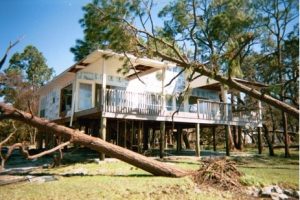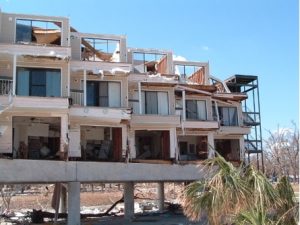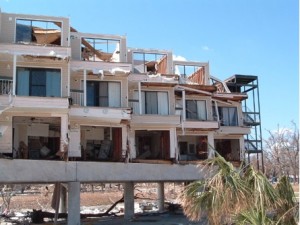
The Federal Emergency Management Agency [FEMA] has established specific damage assessment guidelines enforced by the Building Code Official pertaining to all structures located in SFHA (special flood hazard area) A & V zones. These guidelines are intended to relieve the country of repetitive loss flood claims, referred to as the 50% Rule. The Substantial Damage/Improvement Rule, states that a building must be elevated and brought into compliance if damaged by any cause(s) for which the repair costs are 50% or more of the value of the building, and the building is both in a SFHA and at a non compliant elevation or in some other way non compliant with current building code for new construction. [FEMA Region VII 04/21/97]
The damage can be the result of wind, flood, fire, earthquake or man; the 50% Rule regulation applies to all structures in a designated (SFHA) special flood hazard area [100-Year Floodplain]. When evaluating a structure’s damage, the Building Value, or market value of the structure only, is factored in; the underlying land and exterior improvements are excluded. In many municipalities or counties one may use the tax appraiser’s value plus 20% or have a forensic appraisal done. There are alternative methods of determining Appraised Value including a depreciated line item value which takes into the actual longevity of a select property and is less affected by the “sale” price collected in the Tax assessor’s office.
The FEMA substantial damage rule should not be confused with the “Repairs to Existing Buildings” code called for separately in the International Building Code. This often happens and can be very confusing especially since the International Building Code www.iccsafe.org has gone from one paragraph in 2004 to an entire book with many different levels of alteration or repair today each requiring a different level of upgrade or none at all.
Another facet of the 50% Rule pertains to the Substantial Improvement of a building. This ruling is a potential costs that buyers needs to be aware of. Simply stated, any Pre-FIRM building that is to be remodeled, renovated or improved – when that project cost is 50% or more of the building value – the building will have to be brought into compliance with the NFIP standards including elevation, which may be a deal breaker. Project costs include structural costs, finished materials, built-in appliances, flooring, interior finishes and O&P on the job but these can be normalized to “pre-storm” pricing following an catastrophe. The cost of permitting is not included.
Periodically, FEMA updates and revises the Flood Insurance Rate Maps [FIRM] across the country. When the elevations are digitized they are then referred to DFIRMs. If the revision of these maps includes an increase in the flood elevation requirements for a particular area, then the Post-FIRM buildings in that area will be affected by the 50% Rule. It is important to note that all additions to a Post-FIRM structure must be elevated to or above the current BFE, regardless if they are “substantial” or not.
Elevation Certificates – The first step in understanding your 50 % rule challenge is an elevation certificate. Elevations certificates have gotten better and better over the years and should allow you to understand the elevation of your buildings first and additional floors, grade your required bfe and the zone. This is another part of the program that has seen major changes over the last decade including the requirement to include pictures of the structure as part of the form.

Many communities, based on location and topography, also implement additional “free-board” requirements. For instance, many coastal communities including mine Santa Rosa County enforce a 3-foot free-board requirement, which means that an additional 3′ of elevation is required above whatever flood identified as a base flood.
Another local ruling to consider is Cumulative Costs. The general ruling is that all separate permits for the same structure within a one or two year period are considered to be a single improvement; the time period varies from area to area. Properties with repetitive losses over a five year period are commonly affected by this portion of the programs requirements.
Being informed and aware of all national and local regulations is the best way to protect your property and to fall into compliance. Please understand this is an extremely important site specific issue that requires a professional surveyor, potentially advice from your local flood plain manager, your insurance agent and a real understanding of the costs of restoration to a damaged structure. Mistakes made immediately after a loss can become very expensive as elevating a slab on grade house is many times not cost effective especially with a cap of $30,000 for code on the Flood Insurance Program.
Complete specializes in hurricane damage expert consulting. John Minor, CGC, CFM has worked post-hurricane sites since Opal in 1995; his experience is far reaching – from the Carolina’s to Texas and all along the coast of Florida. The engineers, flood plain managers and contractors of Complete can meet with you to review your preparedness plan, and we will be there afterwards should you ever need us. We specialize in the understanding of the costs repairs necessary to restore buildings damaged by wind, fire, flood manufacturer ofr builder defect.
Call the company the pros choose – call Complete.
